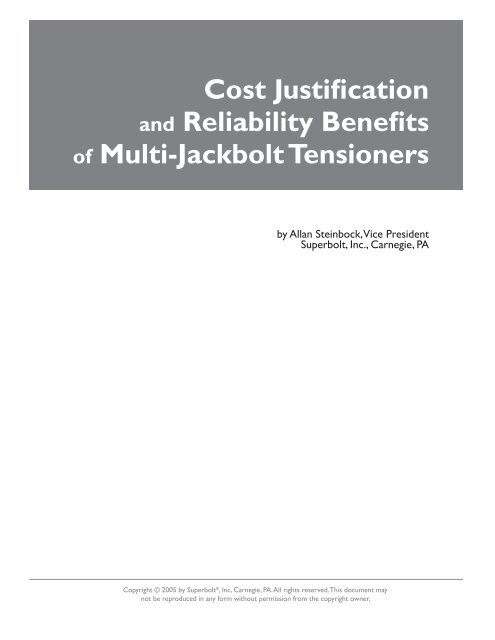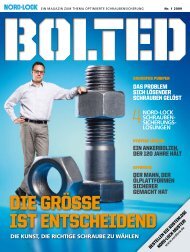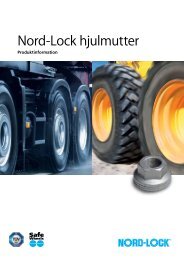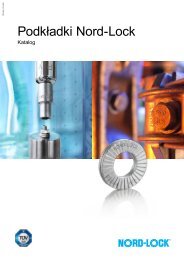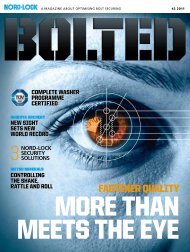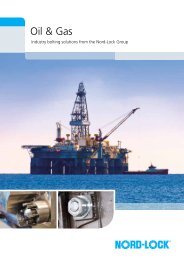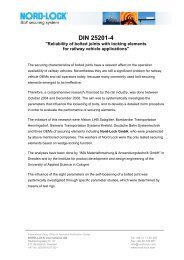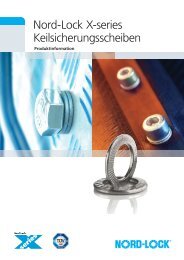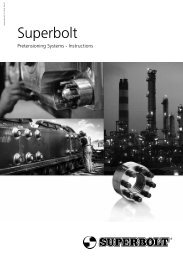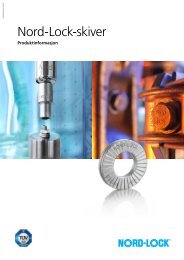Cost Justification and Reliability Benefits of Multi ... - Nord-Lock
Cost Justification and Reliability Benefits of Multi ... - Nord-Lock
Cost Justification and Reliability Benefits of Multi ... - Nord-Lock
You also want an ePaper? Increase the reach of your titles
YUMPU automatically turns print PDFs into web optimized ePapers that Google loves.
<strong>Cost</strong> <strong>Justification</strong><br />
<strong>and</strong> <strong>Reliability</strong> <strong>Benefits</strong><br />
<strong>of</strong> <strong>Multi</strong>-Jackbolt Tensioners<br />
by Allan Steinbock, Vice President<br />
Superbolt, Inc., Carnegie, PA<br />
Copyright © 2005 by Superbolt ® , Inc, Carnegie, PA. All rights reserved. This document may<br />
not be reproduced in any form without permission from the copyright owner.
<strong>Cost</strong> <strong>Justification</strong> <strong>and</strong> <strong>Reliability</strong> <strong>Benefits</strong> <strong>of</strong> <strong>Multi</strong>-Jackbolt Tensioners<br />
INTRODUCTION:<br />
<strong>Multi</strong>-Jackbolt Tensioners are bolt<br />
tightening devices that are widely used<br />
on critical equipment in most heavy<br />
industries. Although the concept is<br />
relatively simple, these tensioners have<br />
many benefits that are not commonly<br />
known. They have proven to be<br />
economical in terms <strong>of</strong> cost <strong>and</strong> in<br />
terms <strong>of</strong> equipment reliability, which<br />
will be the focus <strong>of</strong> this paper.<br />
DESCRIPTION OF SYSTEM:<br />
<strong>Multi</strong>-Jackbolt Tensioners (MJT’s) come<br />
in many variations including nut style,<br />
thrust collars (unthreaded) or bolt style<br />
devices. Due to the wide variety <strong>of</strong><br />
components available, the MJT system<br />
can be retr<strong>of</strong>itted into the same area<br />
as a st<strong>and</strong>ard OEM nut or bolt. This<br />
paper focuses on the nut style tensioner<br />
(Fig. 1) as this is the most commonly<br />
used. However, most <strong>of</strong> the benefits are<br />
applicable to the other designs.<br />
Fig. 1: Nut style <strong>Multi</strong>-Jackbolt Tensioner<br />
The MJT system is composed <strong>of</strong> a round<br />
nut body with an internal thread identical<br />
to a st<strong>and</strong>ard fastener. In between the<br />
thread <strong>and</strong> the outside diameter is a series<br />
<strong>of</strong> drilled <strong>and</strong> tapped holes designed<br />
to accept hardened jackbolts that pass<br />
through the entire nut body. A hardened<br />
washer is always used under the jackbolts<br />
to protect the bearing area <strong>of</strong> the<br />
equipment (Fig. 2).<br />
Fig. 2: Cutaway line drawing <strong>of</strong> typical nut style <strong>Multi</strong>-<br />
Jackbolt tensioner<br />
To apply the system, the hardened washer<br />
is placed over the existing stud, bolt, rod<br />
or shaft to be tightened. The nut body is<br />
then threaded onto the main thread <strong>of</strong> the<br />
st<strong>and</strong>ard fastener h<strong>and</strong> tight against the<br />
washer. The tightening torque is applied<br />
to the individual jackbolts with a st<strong>and</strong>ard<br />
h<strong>and</strong> held torque wrench or air tool.<br />
Turning the jackbolts creates a thrusting <strong>of</strong><br />
the nut body away from the washer surface,<br />
2
3<br />
Fig. 3: Cutaway line drawing <strong>of</strong> MJT installed on stud<br />
or bolt.<br />
creating bolt tension <strong>and</strong> imparting a<br />
stretch on the main thread (Fig 3 & 4).<br />
MJT’s stay in place <strong>and</strong> remain on<br />
the equipment until removal for the<br />
next outage. An equivalent torque on a<br />
st<strong>and</strong>ard fastener can be achieved with a<br />
fraction <strong>of</strong> the torque<br />
input. For example, to<br />
pre-stress a 4”-8tpi bolt to<br />
45,000 psi (520,650 lb. <strong>of</strong><br />
preload) you would need<br />
to torque a st<strong>and</strong>ard nut<br />
to 30,650 ft•lb. With a<br />
st<strong>and</strong>ard MT series MJT,<br />
the same prestress can be<br />
achieved with only 190 ft•lb<br />
on each jackbolt. Figures<br />
5 & 6 show torque values<br />
that indicate the dramatic<br />
mechanical advantage <strong>of</strong><br />
MJT’s compared to st<strong>and</strong>ard<br />
hex nut torque values.<br />
Since applying <strong>Multi</strong>-Jackbolt<br />
<strong>Cost</strong> <strong>Justification</strong> <strong>and</strong> <strong>Reliability</strong> <strong>Benefits</strong> <strong>of</strong> <strong>Multi</strong>-Jackbolt Tensioners<br />
Tensioners as an alternative bolting method<br />
is new to some people, cost justification<br />
<strong>and</strong> reliability issues come to the forefront<br />
when compared to alternative or existing<br />
methods. Although many <strong>of</strong> the equipment<br />
reliability issues tie into cost justification<br />
we will attempt to discuss them separately<br />
<strong>and</strong> prove them with actual case histories.<br />
COST JUSTIFICATION:<br />
INITIAL PURCHASE VS.<br />
ALTERNATIVES<br />
On new equipment <strong>and</strong> retr<strong>of</strong>its, <strong>Multi</strong>-<br />
Jackbolt Tensioners are generally more<br />
expensive than st<strong>and</strong>ard nuts/bolts.<br />
However, in many cases, the existing<br />
nuts <strong>and</strong> bolts are <strong>of</strong> special design or<br />
Fig. 4: 3D model <strong>of</strong> MJTs installed on a joint.<br />
Easy-turn jackbolts push nut<br />
body “up”<br />
MJT spun on h<strong>and</strong> tight<br />
Hardened washer protects joint<br />
surface<br />
Tremendous clamping force is<br />
created on joint<br />
Existing bolt/stud tightened in<br />
pure tension
<strong>Cost</strong> <strong>Justification</strong> <strong>and</strong> <strong>Reliability</strong> <strong>Benefits</strong> <strong>of</strong> <strong>Multi</strong>-Jackbolt Tensioners<br />
materials. In larger size ranges, MJT’s can<br />
be equal to or less than original nuts/<br />
bolts. For example, on a recent job for a<br />
large coupling, (18) 6-13/16” tensioners<br />
were required. The initial cost <strong>of</strong> the<br />
tensioners was equivalent in cost to the<br />
machined st<strong>and</strong>ard nuts. However, in<br />
the comparison <strong>of</strong> MJT’s to alternative<br />
tightening methods is where most cost<br />
justifications occur.<br />
For example, hydraulic wrenching is a<br />
commonly used method <strong>of</strong> torquing<br />
large diameter nut/bolts. The initial<br />
purchase price <strong>of</strong> hydraulic wrenches can<br />
be tens <strong>of</strong> thous<strong>and</strong>s <strong>of</strong> dollars <strong>and</strong> there<br />
are costs <strong>of</strong> accessories such as adapters,<br />
hoses, hydraulic power units <strong>and</strong> special<br />
sockets. Depending on the manufacturer,<br />
in addition to that there can be heavy<br />
maintenance costs <strong>and</strong> reliability issues.<br />
For example, a recent job for a heat<br />
Fig. 5: Torque curve comparing hex nuts & MJT’s.<br />
exchanger had (14) 3-1/4” A193-B7 studs<br />
to be tensioned using MJT’s. The cost<br />
for these <strong>Multi</strong>-Jackbolt Tensioners was<br />
$5,628.00. This compares to a purchase<br />
price <strong>of</strong> around $17,000 for a dedicated<br />
hydraulic wrench. In some instances where<br />
there are hundreds <strong>of</strong> bolts to tighten,<br />
hydraulic wrenches may have less <strong>of</strong> a<br />
cost impact ignoring other factors to be<br />
discussed later.<br />
Another alternative method is hydraulic<br />
tensioning. Hydraulic tensioners are<br />
used as a tool to stretch a bolt but are<br />
removed once bolt tensioning has been<br />
accomplished. Hydraulic tensioners require<br />
longer studs that sit above the st<strong>and</strong>ard<br />
nut. If not set up for these, new studs must<br />
be purchased to utilize the system. The unit<br />
cost <strong>of</strong> hydraulic tensioners is generally<br />
much more expensive than the total cost<br />
<strong>of</strong> <strong>Multi</strong>-Jackbolt Tensioners. Accessories<br />
must be purchased, such as hoses, fittings<br />
<strong>and</strong> power units. The tensioner itself,<br />
however, can be moved from stud to stud<br />
if time is not a factor. <strong>Multi</strong>ple hydraulic<br />
tensioners can be ganged together but there<br />
can be heavy initial cost depending on the<br />
number <strong>of</strong> units used. The tensioners rely on<br />
seals that can be prone to failure.<br />
Bolt heaters are another alternative bolting<br />
method. Depending on the design, these<br />
units can be very expensive to purchase. They<br />
Fig. 6: Hex nut<br />
torque <strong>and</strong><br />
MJT torque<br />
comparison<br />
chart.<br />
4
5<br />
are very slow, have limits in tensioning<br />
power <strong>and</strong> accuracy, <strong>and</strong>, if used carelessly,<br />
can be hazardous to h<strong>and</strong>le.<br />
SAFETY<br />
Aside from the moral implications <strong>of</strong><br />
providing for worker safety, organizations<br />
must be aware <strong>of</strong> the tremendous costs<br />
due to injuries on the job. Because <strong>Multi</strong>jackbolt<br />
Tensioners require only small<br />
h<strong>and</strong> or air tools, they are arguably the<br />
safest bolting method for tightening large<br />
diameter bolts/studs. The sledgehammer<br />
is still probably the most dominant tool<br />
when attempting to bolt up a piece <strong>of</strong><br />
equipment. The brute force method<br />
is prone to h<strong>and</strong>, arm, leg, face, <strong>and</strong><br />
back injuries. For example, the piston<br />
rod to crosshead jamnut connection<br />
on a reciprocating compressor is such<br />
that tightening methods as described<br />
above cannot be utilized. The large nut<br />
is accessed through an inspection door<br />
<strong>and</strong> can be turned using a large, oversize<br />
wrench hooked to an overhead crane<br />
(Fig. 7), floor jack or most commonly, it<br />
is struck with a sledgehammer.<br />
In one real world example, a worker was<br />
using this method on a 2-1/2” piston<br />
rod when the wrench dislodged from the<br />
nut. The wrench then swung up, striking<br />
the worker in the face. The worker was<br />
put on disability for the good part <strong>of</strong> a<br />
year. Subsequently, (36) <strong>Multi</strong>-Jackbolt<br />
Tensioners, similar to Figure 8, were<br />
installed with no further injuries.<br />
Hydraulic wrenches also have safety<br />
<strong>Cost</strong> <strong>Justification</strong> <strong>and</strong> <strong>Reliability</strong> <strong>Benefits</strong> <strong>of</strong> <strong>Multi</strong>-Jackbolt Tensioners<br />
Fig. 7: Example <strong>of</strong> using an overhead crane on a piston<br />
rod to crosshead jamnut connection.<br />
concerns, as they are high-energy tools.<br />
Specific instances <strong>of</strong> injuries are h<strong>and</strong> <strong>and</strong><br />
arm injuries due to sockets exploding or<br />
reaction bars pinching or rotating under<br />
high pressure. Hydraulic pressure in these<br />
units is usually 10,000 psi or higher <strong>and</strong><br />
instances have occurred where a hose<br />
has let go <strong>and</strong> injected a worker with<br />
poisonous hydraulic fluid causing severe<br />
injury. Figure 9 shows a photo <strong>of</strong> sockets<br />
that blew apart on a turbine deck, narrowly<br />
missing the personnel working in the area.<br />
Additionally, large wrenches can also be<br />
very heavy <strong>and</strong> they must be moved into<br />
place to function. This heavy lifting has<br />
contributed to back <strong>and</strong> other injuries.<br />
Fig. 8: <strong>Multi</strong>-Jackbolt Tensioner installed on a<br />
crosshead jamnut.
<strong>Cost</strong> <strong>Justification</strong> <strong>and</strong> <strong>Reliability</strong> <strong>Benefits</strong> <strong>of</strong> <strong>Multi</strong>-Jackbolt Tensioners<br />
Bolt heating has high-energy voltage<br />
requirements <strong>and</strong> also is a source <strong>of</strong><br />
injuries mainly related to burns. There<br />
have been instances where the heaters<br />
have ignited flammable liquids nearby,<br />
causing major fires. This is especially<br />
a concern where hydrocarbons are<br />
involved.<br />
Fig. 9: Damaged sockets from a hydraulic wrench.<br />
SPACE RESTRICTIONS<br />
With the wide range <strong>of</strong> materials available<br />
<strong>and</strong> the flexible nature <strong>of</strong> their design,<br />
MJT’s have been used in many spacerestricted<br />
areas. Special MJT’s have<br />
been designed for applications where<br />
severe costs would have occurred if the<br />
traditional methods were employed. For<br />
example, several cases have occurred<br />
where an end user received a pressure<br />
vessel or heat exchanger where it was<br />
made incorrectly <strong>and</strong> the flange bolt<br />
circle was too tight to use a socket on the<br />
existing nuts. In a recent case, a refinery<br />
had rigging crews on site to install a new<br />
heat exchanger. The maintenance crew<br />
had to make a decision whether to call<br />
Fig. 10: Example <strong>of</strong> tighter stud spacing that is possible<br />
when using MJT’s.<br />
in an on-site machining crew or come up<br />
with an alternative. Due to the small O.D.<br />
requirements on the nuts, ‘turbine’ style<br />
MJT’s with a 1.5x thread diameter O.D.<br />
were fabricated <strong>and</strong> on-site in two days.<br />
This saved the company tens <strong>of</strong> thous<strong>and</strong>s<br />
<strong>of</strong> dollars in losses, as the rigging crews<br />
were able to keep working, not counting<br />
the savings in on-site machine costs.<br />
Some OEM’s are looking to decrease the<br />
overall size <strong>of</strong> their machinery housings<br />
because the stud to stud spacing can be<br />
tighter with MJT’s (Fig. 10).<br />
In some cases, fasteners are located inside<br />
or around a piece <strong>of</strong> equipment that is very<br />
difficult to access, especially with the large<br />
wrenches that are most commonly used.<br />
For instance, some <strong>of</strong> the frame bolting on<br />
reciprocating compressors is located inside<br />
the inspection door <strong>of</strong> the doghouse. The<br />
ease <strong>of</strong> using a h<strong>and</strong> torque wrench makes<br />
reaching these areas easy (Fig. 11).<br />
6
7<br />
Fig. 11: Superbolt ® MJT’s installed on a reciprocating<br />
compressor doghouse.<br />
EASE OF USE<br />
Since only h<strong>and</strong> tools are required <strong>and</strong><br />
since MJT’s tighten studs in pure tension,<br />
there are cost savings vs. other methods.<br />
For example, the piston end nut on<br />
reciprocating compressors generally<br />
requires clamping <strong>of</strong> the piston rod to<br />
torque <strong>and</strong> untorque the nut if work on<br />
the piston is required (Fig. 12a). This can<br />
severely damage the rod surface, which<br />
must slide through packing material that<br />
could also be damaged. In many cases,<br />
the nut has to be machined away to get the<br />
piston <strong>of</strong>f. In one extreme case, a liquid gas<br />
company had a remote plant site <strong>and</strong> every<br />
time they did piston work they loaded the<br />
Fig. 12a: Example <strong>of</strong> jig to hold rod while torquing<br />
piston end nut. Note this is a small unit.<br />
<strong>Cost</strong> <strong>Justification</strong> <strong>and</strong> <strong>Reliability</strong> <strong>Benefits</strong> <strong>of</strong> <strong>Multi</strong>-Jackbolt Tensioners<br />
whole piston <strong>and</strong> rod onto a truck <strong>and</strong><br />
shipped it to a facility to untorque <strong>and</strong><br />
retorque the nuts. By utilizing the <strong>Multi</strong>-<br />
Jackbolt concept, they were able to do the<br />
job on a workbench, saving shipping cost<br />
<strong>and</strong> valuable downtime (Fig. 12b).<br />
Another time saver is the ability to adjust<br />
the bolt prestress in a short time. For<br />
instance, extensiometers are commonly<br />
used to check bolt tension. In the instance<br />
where stud heating is the method, one<br />
must apply heat, let the unit cool, check<br />
the stretch <strong>and</strong> if the value is <strong>of</strong>f, the<br />
whole process must be repeated. With<br />
<strong>Multi</strong>-Jackbolt Tensioners one can dial in a<br />
new torque setting <strong>and</strong> bring up the value in<br />
a matter <strong>of</strong> minutes. As an example, it took<br />
one turbine manufacturer three days to bolt<br />
up a unit for hydro testing with stud heaters<br />
<strong>and</strong> checking with extensiometers. This<br />
was reduced to one day with MJT’s <strong>and</strong><br />
extensiometers.<br />
Large preloads are easily achievable<br />
with h<strong>and</strong> tools only <strong>and</strong> this is <strong>of</strong>ten a<br />
solution to big problems. For example,<br />
a large petrochemical producer was able<br />
to apply high loads to the anchorbolts<br />
on reciprocating compressors <strong>and</strong> in<br />
Fig. 12b: Example <strong>of</strong> larger piston end nut for gas<br />
compressor.
<strong>Cost</strong> <strong>Justification</strong> <strong>and</strong> <strong>Reliability</strong> <strong>Benefits</strong> <strong>of</strong> <strong>Multi</strong>-Jackbolt Tensioners<br />
this case was able to stop movement <strong>of</strong><br />
the compressor avoiding the need to<br />
regrout them. According to the end user,<br />
the estimated cost savings were in the<br />
hundreds <strong>of</strong> thous<strong>and</strong>s <strong>of</strong> dollars.<br />
Many bolting applications in the<br />
petrochemical industry wind up having<br />
the fasteners upside down on part <strong>of</strong> the<br />
equipment. It is very difficult work to lift<br />
heavy tools overhead <strong>and</strong> sometimes the<br />
work even has to be done while laying on<br />
ones back. Figure 13 shows a preheater<br />
being tightened with MJT’s with two men.<br />
Small, light air tools were used except for<br />
the final pass which requires a light h<strong>and</strong><br />
torque wrench. The job was performed<br />
in a tenth <strong>of</strong> the time <strong>and</strong> the workers<br />
were very happy to avoid the discomfort<br />
<strong>of</strong> using the old, heavy tools that were<br />
previously required.<br />
TIME SAVINGS<br />
A very common comment on <strong>Multi</strong>-<br />
Jackbolt Tensioners is that it must take<br />
a long time to torque up all <strong>of</strong> the<br />
Fig. 13: <strong>Multi</strong>-Jackbolt tensioners make bolting in<br />
awkward locations an easier task.<br />
FIG. 14<br />
Fig. 14: <strong>Multi</strong>-Jackbolt tensioners installed on multiple<br />
heat exchangers.<br />
jackbolts, but, in fact, MJT’s have reduced<br />
installation times compared to other<br />
bolting methods. As mentioned in a<br />
previous example, adjustments to the<br />
preload can be made quickly by dialing<br />
in a new torque value <strong>and</strong> torquing the<br />
jackbolts to the new value.<br />
The use <strong>of</strong> air tools also greatly speeds up<br />
the tightening process. Although special<br />
air tools can be purchased to apply a very<br />
accurate torque, it has been found that<br />
with proper guidelines, st<strong>and</strong>ard air impact<br />
tools can do the job without the higher<br />
expense. The st<strong>and</strong>ard procedure calls for<br />
the use <strong>of</strong> air tools to speed up the rounds<br />
<strong>of</strong> tightening <strong>and</strong> taking a final pass with a<br />
calibrated h<strong>and</strong> held torque wrench.<br />
Figure 14 shows a bank <strong>of</strong> heat<br />
exchangers in a refinery. The job required<br />
(96) 3-1/4” studs to be tensioned to 45,000<br />
psi bolt stress. This job previously took 3<br />
days to perform using the previous method<br />
<strong>of</strong> hydraulic wrenches. Using the <strong>Multi</strong>-<br />
Jackbolt system, the only special tooling<br />
required were low-cost in-line regulators<br />
combined with st<strong>and</strong>ard air impact tools. All<br />
8
9<br />
Fig. 15: <strong>Multi</strong>ple workers can be used to further speed<br />
up installation.<br />
four exchangers were bolted up in a total <strong>of</strong><br />
8 hours using two workers.<br />
On some flanges with concealed gaskets<br />
the speed <strong>of</strong> the system can be increased<br />
by selecting four or eight tensioners 180º<br />
apart to bring metal to metal contact <strong>of</strong> the<br />
flanges. The remaining tensioners therefore<br />
do not require additional passes just to<br />
create gasket crush. However, it should be<br />
noted that manufacturer procedures should<br />
not be superseded without consultation.<br />
Another major time savings can be<br />
accomplished by using multiple workers<br />
to tighten several MJT’s simultaneously.<br />
Since only h<strong>and</strong> tools are used, the tooling<br />
required is easily obtainable <strong>and</strong> economical,<br />
especially in emergency situations. Figure 15<br />
shows a job where (18) 6-3/16” tensioners<br />
were tensioned using four workers 90º apart<br />
from each other in a very restricted space.<br />
Extensiometers were used to check stud<br />
stretch <strong>and</strong>, including doing calculations<br />
<strong>and</strong> taking breaks, the entire procedure was<br />
performed in 2-1/2 hours. The previous<br />
method using a combination <strong>of</strong> fabricated<br />
components <strong>and</strong> hydraulic rams was<br />
estimated to have taken 150-200 man hours.<br />
<strong>Cost</strong> <strong>Justification</strong> <strong>and</strong> <strong>Reliability</strong> <strong>Benefits</strong> <strong>of</strong> <strong>Multi</strong>-Jackbolt Tensioners<br />
In a drastic example, for instance on a turbine<br />
casing, as many workers as can fit next to<br />
each other can be working on the unit.<br />
Other time factors that can be encountered<br />
are not that obvious at first glance. For<br />
instance, stud seizure into a blind hole such<br />
as in a turbine housing is a fairly common<br />
occurrence. It can sometimes take several<br />
shifts or even days to remove frozen studs<br />
that <strong>of</strong>ten have to be drilled or machined<br />
out on-site. Since MJT’s tighten a stud in<br />
pure tension, there is no galling or ripping<br />
<strong>of</strong> thread surfaces which can occur when<br />
applying a high torque to achieve stud<br />
tension. Therefore, once the jackbolts are<br />
unloaded in a MJT, the nut body can be<br />
removed leaving the stud as if it had been<br />
h<strong>and</strong> tight. The stud is then easily removed<br />
with nominal torque applied.<br />
In some instances time is saved because<br />
the preparation, such as with the piston rod<br />
example used earlier, is so time consuming<br />
(i.e. clamping the rod in a special jig <strong>and</strong><br />
rigging up special tools to apply a large<br />
turning force. Additionally, valuable crane<br />
time is not wasted on time consuming<br />
bolting.).<br />
RELIABILITY<br />
As some <strong>of</strong> the examples have indicated,<br />
the reliability <strong>of</strong> various equipment can<br />
be improved with the proper utilization<br />
<strong>of</strong> <strong>Multi</strong>-Jackbolt Tensioners. First <strong>and</strong><br />
foremost is the concept <strong>of</strong> preload<br />
versus working load, which is a widely<br />
misunderstood subject. In most bolted<br />
joints which have a through bolt (or stud),<br />
clamping two members together such as
<strong>Cost</strong> <strong>Justification</strong> <strong>and</strong> <strong>Reliability</strong> <strong>Benefits</strong> <strong>of</strong> <strong>Multi</strong>-Jackbolt Tensioners<br />
a flange connection, the preload (or clamping force) must exceed the working load (or<br />
separating force) for the joint to have integrity (See below).<br />
GENERAL BACKGROUND OF PRELOAD:<br />
Preload: although a fully detailed study into bolting principals is above the scope <strong>of</strong> this paper,<br />
some major points need to be discussed. The most important point is the concept <strong>of</strong> preload vs.<br />
working load on a bolted joint. Following is a commonly used example <strong>of</strong> how preload works:<br />
150 lb<br />
A) A fish scale is loaded<br />
with a weight <strong>of</strong> 150 lbs.<br />
The spring represents a<br />
bolt tightened to a tensile<br />
preload <strong>of</strong> 150 lbs.<br />
Preload: Preload <strong>and</strong> working load are<br />
not additive as <strong>of</strong>ten believed. If a bolt<br />
is preloaded to 100,000 lbs, it induces an<br />
equivalent clamping load <strong>of</strong> 100,000 lbs on<br />
the bolted members. Unless the working load<br />
or separating force on the joint approaches<br />
the preload, the bolt does not feel additional<br />
load. In other words, if the separating force<br />
<strong>of</strong> the machine or working load is 50,000 lbs,<br />
B) A block is forced into the<br />
indicated position <strong>and</strong> the<br />
weight is removed.<br />
100 lb<br />
C) A 100 lb. weight is applied to the<br />
system. The assembly now behaves<br />
like a bolt preloaded to 150 lbs <strong>and</strong><br />
an external load <strong>of</strong> 100 lbs. Adding<br />
the weight does not increase the tension<br />
in the spring (which represents<br />
the bolt). If the tension were greater<br />
than 150 lbs, the scale would read<br />
more than 150 lbs <strong>and</strong> the block<br />
would fall out.<br />
the bolt will not be loaded to 150,000 lbs<br />
but will still only have the initial preload <strong>of</strong><br />
100,000 lbs. However, when the working load<br />
exceeds the preload, the joint separates <strong>and</strong><br />
the full working load is carried by the bolt. It<br />
is this situation where the working load cycles<br />
against the heads <strong>of</strong> the bolts or on the faces<br />
<strong>of</strong> the nuts. This is when loosening <strong>and</strong> bolt<br />
breakage occurs.<br />
10
11<br />
IMPORTANCE OF PROPER<br />
PRELOAD<br />
High preloads are required in so many<br />
applications that it would be difficult to<br />
name them all, but a good example is the<br />
pressure vessel. With the institution <strong>of</strong><br />
ASME Sect 8 Div 3 pressure vessel code,<br />
extremely high pressures (over 10,000 psi<br />
system pressure) are allowed for reactors<br />
in various processes. This also means that<br />
the size <strong>of</strong> the reactors <strong>and</strong> the size <strong>of</strong><br />
the studs that seal them have dramatically<br />
increased in size. For instance, pressure<br />
vessels with 8” to 10” diameter studs<br />
are becoming more common. 50,000 psi<br />
stress in a 10” stud requires a preload <strong>of</strong><br />
3,700,000 lbs. It is almost impossible to<br />
torque a hex nut to this load. There are very<br />
few methods that can achieve high stud<br />
stress in large diameter studs without the<br />
time, safety, <strong>and</strong> economic consequences<br />
described earlier. MJT’s can be used in all<br />
pressure vessel codes <strong>and</strong> conform to ASME<br />
<strong>and</strong> ASTM design <strong>and</strong> material requirements.<br />
VIBRATION ISSUES<br />
If proper preload is applied above the working<br />
load, the fasteners will not vibrate loose. Many<br />
“B<strong>and</strong>-Aid” methods have been tried to stop<br />
fasteners from vibrating loose on vibrating<br />
<strong>and</strong> rotating equipment, such as double<br />
nutting, welding a fastener in place, locking<br />
adhesives, locking with cotter pins, <strong>and</strong> many<br />
more. This is fine when the fastener does not<br />
carry much load, but the trouble with this<br />
approach is that the main bolt/stud can still<br />
be going through full loading cycles. Even if<br />
the nuts on the ends do not come loose, stud/<br />
bolt breakage can occur due to the fatigue<br />
<strong>Cost</strong> <strong>Justification</strong> <strong>and</strong> <strong>Reliability</strong> <strong>Benefits</strong> <strong>of</strong> <strong>Multi</strong>-Jackbolt Tensioners<br />
cycles felt by the main tension member.<br />
A good example <strong>of</strong> this was on 4”<br />
reciprocating compressor rod piston end nuts<br />
being used in a large pumping station. The<br />
maintenance procedure was to use a chisel<br />
<strong>and</strong> a hammer to turn against the slots on the<br />
top <strong>of</strong> the nut. The piston nut <strong>and</strong> the rod<br />
were then drilled <strong>and</strong> tapped <strong>and</strong> fitted with a<br />
locking set screw. The customer experienced<br />
loosening <strong>of</strong> the locking screw, which would<br />
dislodge <strong>and</strong> run in the compressor until the<br />
rattle was noticed. Several rod failures also<br />
occurred due to the fatigue exposure when<br />
the nut backed <strong>of</strong>f. After discussing the<br />
situation it was explained that the customer<br />
was only applying roughly 500 ft•lb to the<br />
nut. This translated to only 8,500 lb <strong>of</strong> preload,<br />
which was significantly under the separating<br />
force <strong>of</strong> the rod load. To achieve the necessary<br />
rod stress <strong>of</strong> 25,000 psi (289,250 lb), a torque<br />
<strong>of</strong> 17,000 ft•lb would need to be applied to<br />
the st<strong>and</strong>ard nut. Using the MJT system, the<br />
user was able to achieve the required rod<br />
stress with only 175 ft•lb on each jackbolt.<br />
Due to past practices the end user wanted<br />
to install the locking set screw but was later<br />
convinced that the preload would hold the<br />
system tight. Fifty MJT style Piston end nuts<br />
<strong>of</strong> various sizes have been retr<strong>of</strong>itted with<br />
this user over a seven year period with no<br />
loosening <strong>of</strong> the pistons or nuts.<br />
Many bolted joints in reciprocating machinery<br />
are subject to fatigue failures. The constant<br />
reversal <strong>of</strong> stresses from tension to<br />
compression weakens the metal structures,<br />
which leads to cracks <strong>and</strong> eventually<br />
breakage. The time to failure depends<br />
on the metal used <strong>and</strong> its treatment, the<br />
design <strong>of</strong> the structure (stress risers), the<br />
size <strong>of</strong> stress reversals, <strong>and</strong> the number<br />
<strong>of</strong> cycles. The amount <strong>of</strong> stress reversals
<strong>Cost</strong> <strong>Justification</strong> <strong>and</strong> <strong>Reliability</strong> <strong>Benefits</strong> <strong>of</strong> <strong>Multi</strong>-Jackbolt Tensioners<br />
is more important than the level <strong>of</strong> stress<br />
at which the reversals occur. For example,<br />
fatigue occurs more <strong>of</strong>ten if the reversals<br />
are between 0 <strong>and</strong> 30,000 psi than if they<br />
are between 40,000 <strong>and</strong> 45,000 psi. In most<br />
joints, the amount <strong>of</strong> stress reversal can<br />
be substantially reduced, if not eliminated,<br />
by preloading the joint to a level where the<br />
bolt does not “see” the load change. This is<br />
shown in Fig 16.<br />
Fig. 16: Chart showing joint fatigue life.<br />
TIGHTENING STUDS IN PURE<br />
TENSION<br />
MJT’s tighten studs/bolts in pure tension<br />
created by the axial thrusting <strong>of</strong> the<br />
jackbolts on the nut body. As mentioned,<br />
this prevents thread galling “picking up <strong>of</strong><br />
material” on the surfaces <strong>of</strong> the threads<br />
that can eliminate the need to drill/<br />
machine out frozen studs. Aside from this,<br />
tightening in tension eliminates galling<br />
<strong>of</strong> the spot faces or machined faces <strong>of</strong><br />
the equipment where a nut usually slides<br />
under load. It also eliminates situations<br />
such as where a hex nut is not machined<br />
perfectly perpendicular to the main thread,<br />
which can cause the nut to dig in to the<br />
bearing surface. This can add a large<br />
friction that will affect tension output due<br />
to torque. Up to 5º stud misalignment can<br />
be compensated on applications such as<br />
anchorbolts, which can be slightly <strong>of</strong>f line.<br />
Tightening in tension can also be helpful<br />
when it is critical not to have a turning<br />
moment due to tightening a st<strong>and</strong>ard nut.<br />
There have been instances where<br />
great time <strong>and</strong> expense have been<br />
spent laser aligning a machine only<br />
to throw it out when banging on<br />
the st<strong>and</strong>ard nuts that anchor the<br />
machine down. Also, there are<br />
applications such as on the ends <strong>of</strong><br />
shafts where it is difficult to hold<br />
the shaft steady while torquing the<br />
nut on the end. Tightening in pure<br />
tension eliminates these kind <strong>of</strong><br />
scenarios.<br />
Tightening in tension also eliminates<br />
unwanted torsion in the bolt or stud<br />
that can create crack starters, weakening<br />
the fatigue capacity <strong>of</strong> the bolt. Fatigue<br />
breakage causes unwanted <strong>and</strong> expensive<br />
downtime not to mention the cost <strong>of</strong><br />
expensive studs.<br />
EVEN TENSION AROUND THE<br />
FLANGE<br />
MJT’s are very repeatable with regard<br />
to bolt load (+-10% error or 5% with<br />
calibration). Commonly available bolting<br />
manuals have stated that st<strong>and</strong>ard nuts/<br />
bolts have a 30-40% error in preload<br />
even with a very accurate torque wrench<br />
(+- 3%). Bolting organizations have been<br />
12
13<br />
investigating how many variables affect<br />
preload. There are dozens that mainly<br />
influence the friction factor, such as surface<br />
condition, materials, <strong>and</strong> lubricants... etc.<br />
The scope <strong>of</strong> this subject is beyond this<br />
paper but more information is available<br />
if desired. (Some studies have shown<br />
flange bolts from 0-200% tight due to<br />
multiplication <strong>of</strong> the error from multiple<br />
passes with a wrench.) Other methods<br />
also are prone to error <strong>and</strong> loss <strong>of</strong> preload<br />
when applying shrinkage methods such<br />
as thermal tightening <strong>and</strong> hydraulic<br />
tensioning.<br />
Even tension from bolt to bolt is especially<br />
important when sealing up a gasketed<br />
flange or pressure vessel joint. This helps<br />
eliminate leakage problems associated<br />
with one end <strong>of</strong> a flange having low load<br />
comparatively by creating even pressure<br />
around the flange interface.<br />
ELASTICITY<br />
It is desirable for most bolting systems<br />
to have as much elasticity as possible.<br />
This is also true for high temperature<br />
bolting. Due to creep, joints become<br />
loose after prolonged service <strong>and</strong> start<br />
to leak. Repeated cooling <strong>and</strong> reheating<br />
<strong>of</strong> the system <strong>of</strong>ten aggravates this. Tests<br />
show that turbine-type MJT’s will add<br />
the approximate equivalent <strong>of</strong> four stud<br />
diameters to the elasticity <strong>of</strong> bolting<br />
systems; this is an increase <strong>of</strong> 50-100%<br />
in elasticity for an average bolting system.<br />
Since creep continues at a uniform rate at<br />
a given temperature, this extra elasticity<br />
can significantly prolong the service life <strong>of</strong><br />
high temperature joints.<br />
<strong>Cost</strong> <strong>Justification</strong> <strong>and</strong> <strong>Reliability</strong> <strong>Benefits</strong> <strong>of</strong> <strong>Multi</strong>-Jackbolt Tensioners<br />
ELASTICITY OF MJT’S IN<br />
GASKETED JOINTS<br />
In conventional gasketed joints, a gasket<br />
is placed between the raised faces <strong>of</strong> two<br />
flanges <strong>and</strong> then clamped by a number<br />
<strong>of</strong> bolts. The clamping forces have to<br />
be sufficient to resist the blowout <strong>of</strong> the<br />
gasket by the pressure acting on the flange.<br />
The gasket is more or less compressed by<br />
the clamping forces <strong>and</strong> will stabilize at a<br />
certain thickness. If conditions in the joint<br />
remained stable, the joint would probably<br />
last forever.<br />
In an actual working joint, however,<br />
conditions are not stable. The gasket can<br />
be attacked by its environment <strong>and</strong> shrink<br />
or exp<strong>and</strong>. Internal pressures can fluctuate,<br />
changing load conditions on the gasket<br />
<strong>and</strong> thus fatiguing it. Heat can act on<br />
the gasket in several ways. It can change<br />
the chemical state <strong>of</strong> the gasket, it can<br />
change the gasket’s elasticity <strong>and</strong> strength,<br />
<strong>and</strong> it can cause the load on the gasket<br />
to fluctuate due to thermal expansions<br />
<strong>and</strong> contractions <strong>of</strong> the various joint<br />
components. If during the operation <strong>of</strong> a<br />
gasketed joint the gasket gets thinner for<br />
any <strong>of</strong> these reasons, the joint may lose its<br />
integrity, <strong>and</strong> the gasket may blow out from<br />
the pressure acting on the joint.<br />
Whether a gasketed joint loses its integrity<br />
or not depends partly on the gasket<br />
material, but the bolting system employed<br />
is just as important to the integrity <strong>of</strong> the<br />
joint. For example, a gasket may be 0.0625<br />
inches thick when new, but after tightening,<br />
it may be compressed to 0.050 inches.<br />
While the gasket is being compressed by
<strong>Cost</strong> <strong>Justification</strong> <strong>and</strong> <strong>Reliability</strong> <strong>Benefits</strong> <strong>of</strong> <strong>Multi</strong>-Jackbolt Tensioners<br />
0.0125 in., the bolts will be stretched. The<br />
elongation <strong>of</strong> the bolt depends on its<br />
original length <strong>and</strong> the stress in the bolt<br />
after tightening.<br />
Example 1: If the grip length <strong>of</strong> a bolt is<br />
4 in <strong>and</strong> the bolt is tightened to a stress<br />
<strong>of</strong> 45,000 psi as shown in Fig. 17, it will<br />
stretch 0.006 in. Now assume that the<br />
gasket only shrinks 0.003 in. The remaining<br />
elongation in the bolt will only be 0.003”,<br />
which means that the stress in the bolt<br />
will be only 22,500 psi. The joint has lost<br />
50% <strong>of</strong> its tension. What we have in this<br />
example is a stubby rigid bolting system.<br />
Example 2: If a bolt is three times as long<br />
as the one in Example 1, it will be 12” long<br />
initially. The elongation = 3 x 0.006 (which<br />
is 0.018) at 45,000 psi stress as shown in<br />
Fig 18. If the gasket now shrinks the same<br />
0.003” as in Example 1, the remaining<br />
elongation in the bolt is still 0.015”. The<br />
stress in the bolt is still 37,500 psi, <strong>and</strong> the<br />
joint has lost only 16.7% <strong>of</strong> its original<br />
tension. This is an example <strong>of</strong> a relatively<br />
elastic bolting system.<br />
Tests have shown that nut-type MJT’s<br />
can add elasticity to an average bolting<br />
system. St<strong>and</strong>ard nut-type MJT’s will add<br />
as much as 4 to 12 diameter equivalents<br />
to the elasticity <strong>of</strong> bolting systems. If one<br />
considers that the average clamping length<br />
<strong>of</strong> a bolt is around four diameters, it can<br />
be concluded that nut-type MJT’s will triple<br />
or quadruple the elasticity <strong>of</strong> the average<br />
bolting system. It is rather easy to establish<br />
the relative elasticity in an MJT bolting<br />
system. The procedure is illustrated in Fig<br />
19.<br />
STRESS RELIEF THROUGH<br />
MJT’s<br />
The interaction <strong>of</strong> the jackbolt force <strong>and</strong><br />
the opposing force <strong>of</strong> the main bolt creates<br />
a bending moment. Since the bending<br />
moment is created in a circular manner, the<br />
resulting stress in nut-type MJT’s is a hoop<br />
stress. The hoop stress causes an increase<br />
<strong>of</strong> the tensioner diameter at the bottom<br />
<strong>and</strong> a decrease <strong>of</strong> the diameter at the top<br />
as shown in Figure 20.<br />
Fig. 17: Application example 1. Fig. 18: Application example 2 - a more elastic system.<br />
14
15<br />
It is well known that most bolts fail at<br />
the bottom <strong>of</strong> the nut in the first two<br />
or three threads because <strong>of</strong> the stress<br />
concentrations that occur in that region <strong>of</strong><br />
a rigid nut. Tests have shown that the flex<br />
action <strong>of</strong> a nut-type MJT can sufficiently<br />
Fig. 19: The elasticity <strong>of</strong> an MJT can be<br />
established by measuring the bolt elongation<br />
after loading. This indicates the actual tension<br />
in the bolt. Measuring the gap between the nut<br />
body <strong>and</strong> the hardened washer measures the<br />
elasticity <strong>of</strong> the bolt plus the nut body. There is<br />
more elasticity in the pintle <strong>of</strong> the jackbolts. The<br />
elasticity in the pintle cannot be measured, but it<br />
can be calculated using Hooke’s Law.<br />
(a)<br />
<strong>Cost</strong> <strong>Justification</strong> <strong>and</strong> <strong>Reliability</strong> <strong>Benefits</strong> <strong>of</strong> <strong>Multi</strong>-Jackbolt Tensioners<br />
relieve the concentration <strong>of</strong> stresses to<br />
increase the static bearing capacity <strong>of</strong> high<br />
strength bolts by as much as 15%. (Low<br />
strength, ductile type bolts are not much<br />
affected by the stress-relieving action <strong>of</strong><br />
MJT’s). MJT’s also increase the fatigue<br />
resistance <strong>of</strong> dynamically stressed bolts,<br />
but it is difficult to put a numerical value to<br />
that. The amount <strong>of</strong> stress relief depends<br />
primarily on the detail design <strong>of</strong> the MJT.<br />
Basically it can be stated that the higher<br />
the hoop stress in the MJT, the more stress<br />
relief one can expect. Most MJT’s are<br />
designed to have hoop stress equal to twothirds<br />
to three-fourths <strong>of</strong> the main bolt<br />
stress. This ensures that the bolt will always<br />
fail before the MJT does; it also establishes<br />
hoop stresses large enough to substantially<br />
relieve stress concentrations in the critical<br />
bolt thread areas.<br />
The stress relieving action <strong>of</strong> nut-type<br />
MJT’s is simulated in a flexible flange<br />
nut as shown in Fig 21. The flanged nut<br />
(or Flexnut) bears on the outside <strong>of</strong> the<br />
flange, thus creating the desired bending<br />
Fig. 20: Schematic <strong>of</strong> stress-relieving action by torquing a nut-type MJT. (a) Before torquing; (b) after torquing.<br />
Flexing as shown is highly exaggerated.<br />
(b)
<strong>Cost</strong> <strong>Justification</strong> <strong>and</strong> <strong>Reliability</strong> <strong>Benefits</strong> <strong>of</strong> <strong>Multi</strong>-Jackbolt Tensioners<br />
moment. Flexnuts are used<br />
extensively in combination<br />
with bolt-type MJT’s.<br />
However, they are not<br />
very suitable for replacing<br />
st<strong>and</strong>ard hex nuts because<br />
they require excessive<br />
torque if tightened directly.<br />
Flexnuts are designed to<br />
flex out at the bottom <strong>and</strong><br />
flex in toward the top.<br />
This distributes the bolt<br />
along more threads, adds<br />
elasticity, <strong>and</strong> prevents stress<br />
concentrations in the first few threads.<br />
CONCLUSION<br />
<strong>Multi</strong>-jackbolt tensioners <strong>of</strong>fer the benefits<br />
<strong>of</strong> properly loading studs <strong>and</strong> bolts with<br />
the use <strong>of</strong> small h<strong>and</strong> <strong>and</strong> air tools. <strong>Cost</strong><br />
justification is accomplished on many<br />
levels; the most significant <strong>of</strong> which is<br />
related to reducing expensive downtime.<br />
The speed <strong>of</strong> applying the system along<br />
with the reliability <strong>and</strong> fatigue resistance<br />
gets equipment on line faster <strong>and</strong> keeps it<br />
together once it is installed.<br />
In most cases, the system is more<br />
economical than other bolting methods<br />
to purchase <strong>and</strong> it provides a means for<br />
personnel to do their job safely. <strong>Reliability</strong><br />
is enhanced with the added elasticity <strong>and</strong><br />
the uniform preload capabilities. Safety,<br />
economic <strong>and</strong> environmental concerns<br />
created by leakage problems are eliminated.<br />
Fig. 21: Schematic <strong>of</strong> stress-relieving action <strong>of</strong> flanged nuts in<br />
combination with bolt-type MJT’s.<br />
About the author: Allan Steinbock is Vice<br />
President <strong>of</strong> Superbolt ® , Inc. <strong>and</strong> has been with<br />
the company since 1984. He has a Bachelor <strong>of</strong><br />
Science Degree in Mechanical Engineering from<br />
the University <strong>of</strong> Pittsburgh <strong>and</strong> is a member <strong>of</strong><br />
SME <strong>and</strong> other industry specific organizations.<br />
Allan has consulted on thous<strong>and</strong>s <strong>of</strong> bolting<br />
projects <strong>and</strong> has designed products for a broad<br />
range <strong>of</strong> industries.<br />
16


